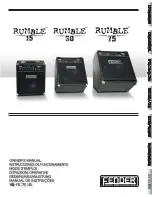
Page 8
Thunderfunk Bass Amp Owner’s Manual
April 2007 - revision 8
Thunderfunk Bass Amp Owner’s Manual
from a mixing console or another preamp to the Power Amp input of the Thunderfunk. This is where you
would connect the special XLR to Phone jack cable, mentioned in the Post EQ Balanced section of this
manual, to connect or “daisy chain” several Thunderfunk slave amps together, matching the setup with
one set of preamp controls working all the Thunderfunk slave power amps.
Speaker Output
–These two ¼ inch jacks are wired in parallel to accept traditional speaker connection
cables. There are also Speakon Connectors (the TFB420 has one, while the TFB550 has two) to accept
modern speaker connections.
The total speaker system impedance may not be lower than 4 Ohms.
Doing so will void the warranty.
Your speaker system should be chosen for the characteristics of your amplifier, your style, and your
application. If you will only be using one cabinet, a 4
Ω
model will draw the most power from your
amplifier. If you will generally be using two cabinets, they should be 8
Ω
models so their combined
impedance will be 4 ohms. Cabinets with 10” speakers sound different than cabinets with 15” speakers.
Beware of 2x10 cabinets that are rated at 4 ohms. They will draw maximum power from the amp and may
not be rated for so much power. Adding a second 2x10 - 4
Ω
cabinet will load the amp to 2 ohms, and
could possibly overheat the amp depending on how hard it‘s driven. The amp will produce only a slight
amount of additional power at 2 ohms and the fan should definitely be left on. It is not a good idea to run
the amp this way.
As a reminder, the actual volume of your system is determined by many elements, the most important
being the sensitivity of the connected speakers. A speaker system with a sensitivity that is 3 dB higher
will, for the same volume, will use about ½ the power of the lower sensitivity speaker system.
Fuse
– As needed, and only after disconnecting the power cord from the amplifier, remove the fuse by
using a standard flat screwdriver, twisting counterclockwise about 1/8
th
turn. The spring-loaded fuse will
partially pop out for easy replacement.
REPLACE WITH ONLY THE SAME SIZE AND TYPE
as labeled
on the back of the amp
.
DO NOT USE FAST BLOW FUSES. (See “Voltage Selector” section below)
Power Cord
– A standard power cord is attached, rated for 120 VAC at 600 watts. In an emergency,
spare power cords are available at computer, and Radio Shack stores.
Voltage Selector
-
The TFB550 is designed to operate at 50 or 60 Hz. To set the voltage for different
areas around the world, remove the two screws that attach the Voltage Selector Coverplate, located at the
far left, above the AC input connector. A voltage setting guide is printed under the plate. To set for 100
volts (Japan) the top switch should be set to 100V and the bottom switch set to +0V. For 120 volts, set the
top switch to 100V and the bottom switch to +20V. For the EU determine what your actual voltage is.
Although the EU has “standardized” on 230 volts, countries still run between 220 and 240 volts. For 220
volts set the top switch to 220V and the bottom switch to +0V. For 240 volts, set the top switch to 220V
and the bottom switch to +20V. For 230 volts, set the amp to operate at 240 volts.
FUSE:
If you change from 100-120 volts to 220-240 volts, or back, you need to also change the value of
the Fuse. The fuse is an American 3AG size slo-blo rated at 6-¼” for 100-120 volts, and 3 amps for 220-
240 volts. You should always check the voltage selector switches whenever you’re unsure of what the
amp is set to.
You can operate the amp in the U.S. at 240 volts if you set the switches to 240 volts.
Plugging the amp into 100-120 volts when the selector switches are set to 220-240 volts WILL NOT
DAMAGE the amp. HOWEVER, plugging into 220-240 volts when the switches are set to 100-120 volts
WILL DAMAGE the amp.
Power cords are NOT supplied with amps that are shipped to countries that operate on voltages other
than 120 volts. Always check the switch settings before plugging the amp in for the first time.

































